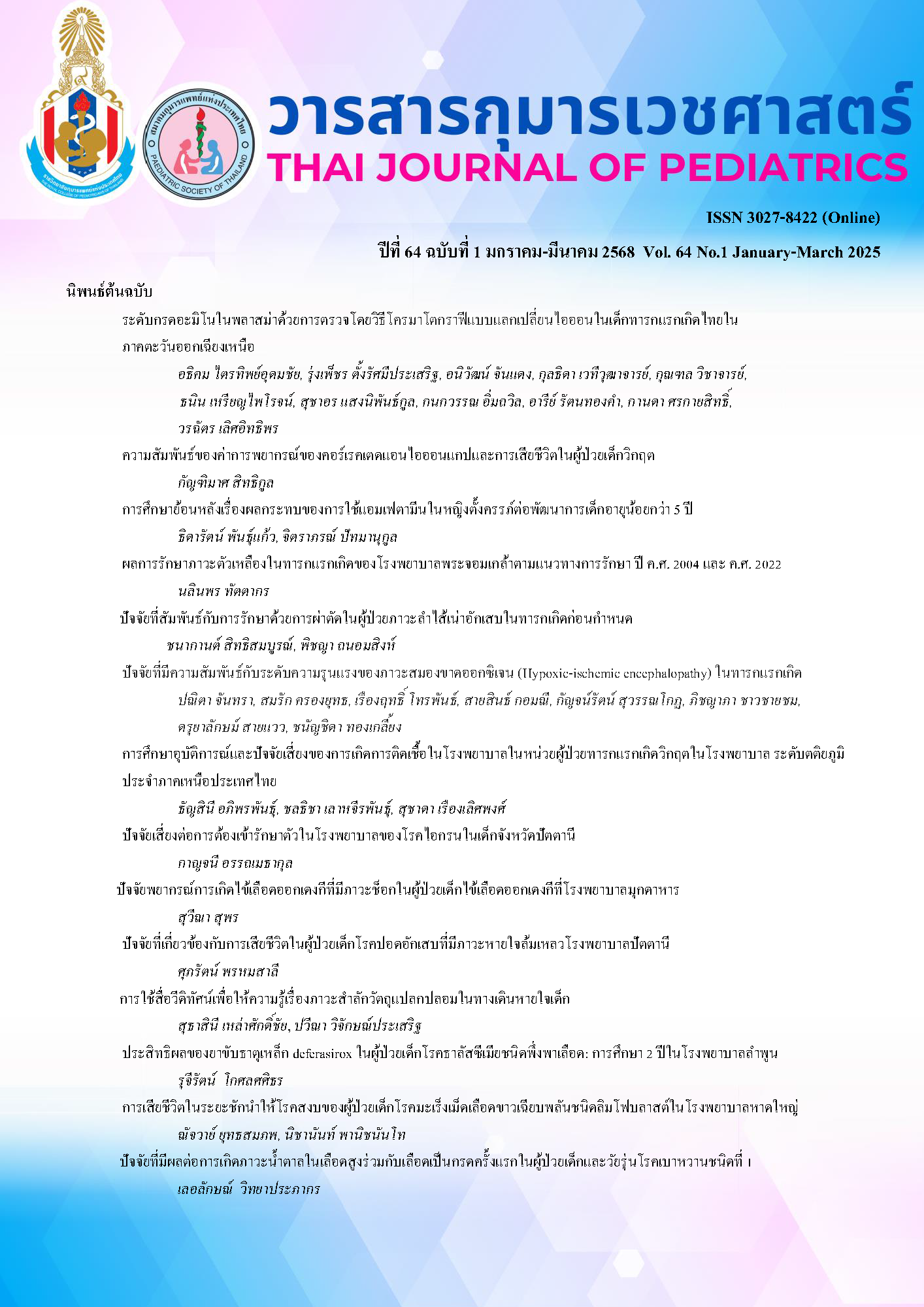ปัจจัยที่สัมพันธ์กับการรักษาด้วยการผ่าตัดในผู้ป่วยภาวะลำไส้เน่าอักเสบในทารกเกิดก่อนกำหนด
คำสำคัญ:
ปัจจัยที่สัมพันธ์, ลำไส้เน่าอักเสบ, ทารกเกิดก่อนกำหนด, การรักษาโดยการผ่าตัดบทคัดย่อ
ความเป็นมา: ภาวะลำไส้เน่าอักเสบเป็นสาเหตุสำคัญที่ทำให้ทารกเกิดก่อนกำหนดเสียชีวิต การหาปัจจัยสัมพันธ์กับการเกิดลำไส้เน่าอักเสบระยะที่ 3 ที่จำเป็นต้องรักษาโดยการผ่าตัดอาจช่วยให้ได้รับการรักษาที่เร็วขึ้น และทำให้ผลลัพธ์ของการรักษาดีขึ้น
วัตถุประสงค์: ศึกษาปัจจัยที่สัมพันธ์กับการเพิ่มความเสี่ยงที่ทำให้เกิดลำไส้เน่าอักเสบระยะที่ 3ในทารกเกิดก่อนกำหนด ที่มีภาวะลำไส้เน่าอักเสบ
วิธีการศึกษา: ทำการศึกษาเก็บข้อมูลย้อนหลังในทารกเกิดก่อนกำหนดอายุครรภ์น้อยกว่า 37 สัปดาห์ที่ได้รับการวินิจฉัยภาวะลำไส้เน่าอักเสบระหว่างวันที่ 1 มกราคม 2560 ถึงวันที่ 31 ธันวาคม 2564 จำนวน 131 คน เก็บข้อมูลพื้นฐาน ข้อมูลทางคลินิก ผลตรวจห้องปฏิบัติการ วิเคราะห์ปัจจัยที่มีผลต่อการเกิดภาวะลำไส้เน่าอักเสบระยะที่ 3 ด้วยสถิติ multivariable logistic regression
ผลการศึกษา: ในผู้ป่วยที่ได้รับการวินิจฉัยว่าเป็นลำไส้เน่าอักเสบทั้งหมด 131 รายมีทารกเกิดก่อนกำหนดที่ได้รับการวินิจฉัยว่ามีลำไส้เน่าอักเสบระยะที่ 3 จำนวน 38 ราย ปัจจัยที่สัมพันธ์กับการเกิดลำไส้เน่าอักเสบระยะที่ 3 ที่ต้องรักษาโดยการผ่าตัด ได้แก่ ค่าเกล็ดเลือดในวันที่วินิจฉัยวันแรกโดยมี cut- off ที่ < 100,000 /cu.mm. (OR 6.0, 95%CI 1.2 – 30.1) ค่าอัลบูมินในเลือดในวันที่วินิจฉัยวันแรกมี cut-off ที่ < 2.8 g/dL (OR 4.9, 95%CI 1.1 – 21.4) และค่า APGAR นาทีที่ 5 ที่น้อยกว่า7 (OR 8.5, 95%CI 1.1 – 69.7) อัตราการเสียชีวิตในกลุ่มลำไส้เน่าอักเสบระยะที่ 3 คิดเป็นร้อยละ 58
สรุป: ปัจจัยที่สัมพันธ์กับการเกิดลำไส้เน่าอักเสบระยะที่ 3 ที่ต้องการรักษาโดยการผ่าตัด ได้แก่ ค่าเกล็ดเลือด ระดับอัลบูมินในเลือด ในวันแรกที่ได้รับการวินิจฉัยลำไส้เน่าอักเสบ และ APGAR score นาทีที่ 5 ที่ต่ำ
Downloads
เอกสารอ้างอิง
Yee WH, Soraisham AS, Shah VS, Aziz K, Yoon W, Lee SK, et al. Incidence and timing of presentation of necrotizing enterocolitis in preterm infants. Pediatrics. 2012;129:e298-304.
Prachukthum S, Seephan S, Kuansathit N, Buadprakhon L, Sumdangchai Y, Kositamongkol S. Risk factors of necrotizing enterocolitis in preterm infants. Thammasat Med J. 2017;17:660-70.
Sharma R, Hudak ML. A clinical perspective of necrotizing enterocolitis: Past, present, and future. Clin Perinatol. 2013;40:27–51.
Hau EM, Meyer SC, Berger S, Goutaki M, Kordasz M, Kessler U. Gastrointestinal sequelae after surgery for necrotising enterocolitis: A systematic review and meta-analysis. Arch Dis Child Fetal Neonatal Ed. 2019;104:F265-73.
Ji J, Ling XB, Zhao Y, Hu Z, Zheng X, Xu Z, et al. A data-driven algorithm integrating clinical and laboratory features for the diagnosis and prognosis of necrotizing enterocolitis. PLoS One. 2014 28;9:e89860.
Cuna AC, Reddy N, Robinson AL, Chan SS. Bowel ultrasound for predicting surgical management of necrotizing enterocolitis: a systematic review and meta-analysis. Pediatr Radiol. 2018;48:658-66.
Khalak R, D'Angio C, Mathew B, Wang H, Guilford S, Thomas E, et al. Physical examination score predicts need for surgery in neonates with necrotizing enterocolitis. J Perinatol. 2018;38:1644-50.
El Manouni El Hassani S, Niemarkt HJ, Derikx JPM, Berkhout DJC, Ballón AE, de Graaf M, et al. Predictive factors for surgical treatment in preterm neonates with necrotizing enterocolitis: A multicenter case-control study. Eur J Pediatr. 2021;180:617-25.
Sharif SP, Friedmacher F, Amin A, Zaki RA, Hird MF, Khashu M, et al. Low serum albumin concentration predicts the need for surgical intervention in neonates with necrotizing enterocolitis. J Pediatr Surg. 2020;55:2625-9.
Sample size for a cohort study [Internet]. EpiTools. [cited 2021 Oct 10]. Available from: http://epitools.ausvet.com.au/content.php?page=cohorts.
Javid PJ, Rggle KM, Smith C. Necrotizing enterocolitis and short bowel syndrome. In: Avery’s Diseases of the Newborn. Elsevier; 2018. p. 1090-7.e2.
Duci M, Fascetti-Leon F, Erculiani M, Priante E, Cavicchiolo ME, Verlato G, et al. Neonatal independent predictors of severe NEC. Pediatr Surg Int. 2018;34:663-9.
Leite HP, Rodrigues da Silva AV, de Oliveira Iglesias SB, Koch Nogueira PC. Serum albumin is an independent predictor of clinical outcomes in critically Ill children. Pediatr Crit Care Med. 2016 ;17:e50-7.
Mohd Amin AT, Zaki RA, Friedmacher F, Sharif SP. C-reactive protein/albumin ratio is a prognostic indicator for predicting surgical intervention and mortality in neonates with necrotizing enterocolitis. Pediatr Surg Int. 2021;37:881-6.
ดาวน์โหลด
เผยแพร่แล้ว
รูปแบบการอ้างอิง
ฉบับ
ประเภทบทความ
สัญญาอนุญาต
ลิขสิทธิ์ (c) 2025 ราชวิทยาลัยกุมารแพทย์แห่งประเทศไทย และ สมาคมกุมารแพทย์แห่งประเทศไทย

อนุญาตภายใต้เงื่อนไข Creative Commons Attribution-NonCommercial-NoDerivatives 4.0 International License.


